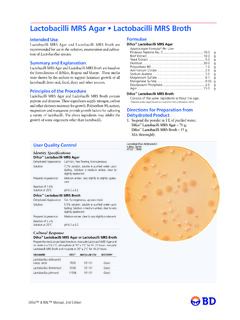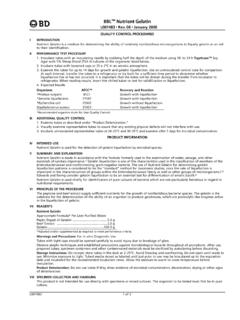Transcription of BBL™ Mueller Hinton II Broth (Cation-Adjusted)
1 BBL Mueller Hinton II Broth (Cation-Adjusted). L007475 Rev. 13 April 2015 . QUALITY CONTROL PROCEDURES. I INTRODUCTION. Mueller Hinton II Broth is cation-adjusted for calcium and magnesium ions and is used for quantitative susceptibility testing of gram-negative and gram-positive aerobic bacteria with a variety of antimicrobial agents. II PERFORMANCE TEST PROCEDURE. 1. Inoculate representative samples with the cultures listed below. a. Inoculate the tubes using sterile pipettes with a dilution containing approximately 1000 mL.
2 Mix well. b. Incubate tubes with loosened caps at 35 2 C in an aerobic atmosphere. Include an uninoculated tube as a growth control. 2. Examine tubes after 18 24 h for growth. 3. Expected Results Organisms ATCC Recovery *Enterococcus faecalis 29212 Growth *Escherichia coli 25922 Growth *Pseudomonas aeruginosa 27853 Growth *Staphylococcus aureus 29213 Growth *Recommended organism strain for User Quality Control. III ADDITIONAL QUALITY CONTROL. 1. Examine tubes as described under Product Deterioration.. 2. Visually examine representative tubes to assure that any existing physical defects will not interfere with use.
3 3. Determine the pH potentiometrically at room temperature for adherence to the specification of 4. Incubate uninoculated representative tubes at 20 25 C and 30 35 C and examine after 7 days for microbial contamination. PRODUCT INFORMATION. IV INTENDED USE. Mueller Hinton II Broth is intended for use in quantitative procedures for susceptibility testing of rapidly-growing aerobic and facultatively anaerobic bacteria isolated from clinical specimens. It is formulated to have a low thymine and thymidine content and is adjusted to the calcium and magnesium ion concentrations recommended in the CLSI standard V SUMMARY AND EXPLANATION.
4 The development of laboratory tests to determine the activity of antimicrobial agents has paralleled the development of these agents. In 1929, Fleming used a serial dilution technique to measure the lowest concentration of penicillin that prevented growth of a test organism in Ericsson and Sherris published an excellent review of the various methods for susceptibility testing and the relationship of dilution and diffusion Rammelkamp and Maxon were among the earliest to use the tube dilution test to determine the in vitro antimicrobial susceptibility of bacteria isolated from clinical The development of this test resulted from the need to know why
5 Some patients infected with Staphylococcus aureus did not respond to penicillin therapy. The tube dilution test ( Broth dilution) involves exposing bacteria to decreasing concentrations of antimicrobial agents in liquid media, usually by serial 2-fold dilution. The mixture, consisting of microorganisms, nutrient medium and antimicrobial agent, is incubated at 35 C for 16 20 h. The lowest concentration of antimicrobial agent at which no visible growth occurs is defined as the minimal inhibitory concentration (MIC).
6 Mueller Hinton Broth is the medium usually used for dilution antimicrobial susceptibility tests. This medium is supplemented with calcium and magnesium salts to produce correct MICs with aminoglycosides and Pseudomonas The term microdilution appeared in the literature in 1970 to describe the minimal inhibitory concentration tests performed with volumes of mL or less of antimicrobial Correlations between MIC values using microdilution and tube dilution methodologies have been reported to be between 85 and 96%.
7 6,7. The qualitative disc diffusion antimicrobial susceptibility procedure has been standardized since The rationale for an MIC. susceptibility test rather than the disc diffusion test is that it gives quantitative information. It provides a relationship between the amount of antimicrobial agent required to inhibit the growth of an organism in vitro and the achievable concentrations in the blood, urine, cerebrospinal fluid or bile, under various dosage conditions. It has been suggested that in the treatment of systemic infections, the drug dosage should yield a peak concentration at the site of infection that is two to four times greater than the MIC value, while for urinary tract infections, a peak urine concentration of 10 to 20 times the MIC value should be However, effective antimicrobial therapy also depends on many other VI PRINCIPLES OF THE PROCEDURE.
8 The acid hydrolysate of casein and beef extract provide nutrients for growth of test organisms. These ingredients are selected for low thymine and thymidine content as determined by MIC values with Enterococcus faecalis and sulfamethoxazole-trimethoprim (SXT). Calcium and magnesium ion concentrations are adjusted to provide the amounts recommended by CLSI1 to give the correct MIC values with aminoglycosides and Pseudomonas aeruginosa. The pH has been adjusted to the specification in M7-A7. Antimicrobial agents are prepared in serial 2-fold dilutions in Mueller Hinton II Broth and are inoculated with the test culture to give a final concentration of 5 x 105 CFU/mL.
9 Following incubation at 35 C, the presence of turbidity indicates growth of the organism. The lowest concentration of antimicrobial agent showing no growth is the MIC of that organism for that agent. L007475 1 of 4. VII REAGENTS. Mueller Hinton II Broth (Cation-Adjusted). Approximate Formula* Per Liter Purified Water Beef g Acid Hydrolysate of g g * Adjusted and/or supplemented as required with appropriate salts toprovide 20 25 mg/L of calcium and 10 mg/L of magnesium andas additionally required to meet performance criteria.
10 Warnings and Precautions: For in vitro Diagnostic Use. Tubes with tight caps should be opened carefully to avoid injury due to breakage of glass. Observe aseptic techniques and established precautions against microbiological hazards throughout all procedures. After use, prepared tubes, specimen containers and other contaminated materials must be sterilized by autoclaving before discarding. Storage Instructions: On receipt, store tubes in the dark at 2 25 C. Avoid freezing and overheating. Do not open until ready to use.










